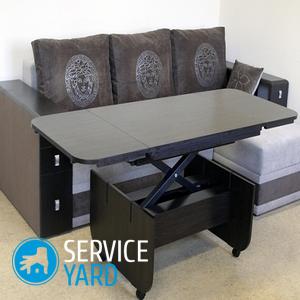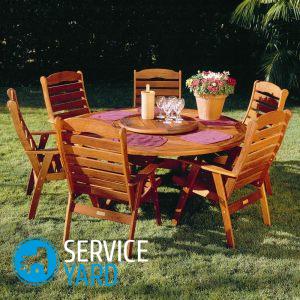Do-it-yourself transformer bench - drawings, sizes

Every landlord wants the landscape design in his garden to be perfect. To do this, a lot of people put in a lot of effort, investing a lot of money, but in practice you can do much less. A high-quality do-it-yourself transformer bench, drawings, the dimensions of which are very simple, can not only decorate your palisade, but also add a lot of amenities. About how to make such furniture, we will tell in this article.
to contents ↑Design advantages
Before proceeding to manufacture, it is worth learning the advantages of this type of design:
- Such country furniture does not take up much space - this indicates its compactness, practicality.
- It is also worth mentioning that such a piece of outdoor furniture is easy to move.
Important! If you make the bench in the right way, it will be quite heavy, but at the same time, quite convenient both in carrying and in operation.
- If necessary, such a seat can be easily turned into a table with two neat benches by simple manipulations. This is perhaps the most important plus of this design.
Materials and Tools
To make a transformer bench with your own hands according to the drawings, you need to prepare the following items for work:
- Edged board.
- Timber.
- Hacksaw for metal and wood (can be replaced by a grinder).
- Roulette.
- Electric drill, drill.
- Sandpaper.
- Phillips screwdrivers.
- Nuts, bolts.
- Paint the right color.
- Wide brush.
- Varnish for wood.
- Stain.
Manufacture
In manufacturing, the most difficult thing is to preserve in the head an abstract image of how the final result should look. To do this is sometimes very difficult due to the fact that the mechanism is mobile. At the very beginning of the work, it is necessary to prepare all the fixed elements, which during the work will be connected to each other.
So, let's move on to the manufacture of a table-bench transformer with our own hands according to the drawings:
- The first step is to make elements that will then serve as legs. To do this, it is necessary to cut 8 identical segments of 70 cm each, to make oblique sections on all of them, which will be located below and above - so you can achieve the necessary balance when working on a slope.
- Make a frame for two benches from the cooked edged board. For this purpose, you need to cut four segments of 40 cm and the same of 170 cm. Cut the angles on each segment so that it is possible to form two identical oblong rectangles.
Important! When connecting these rectangles, you can use nails or screws, and in the second case, you will need to pre-drill a hole.
- In the frame, make reinforcing elements that will finally form the seat. To do this, you need to use a wooden beam, nail it in increments of 50 cm. This will not only be further divided into sections, but also protection from deformation from the sides.
- The legs of the folding table-bench with your own hands must be attached to the seat exactly 10 cm from the corners diagonally. This is best done in such a way that the joints are either next to the “seams” on the seat, or a little off. The quality component should be given the most attention, that is, fastened to 2 or 3 bolts that pass through the beam and, at the same time, the upper part of the legs.In the prepared bar, make grooves - this is necessary in order to hide the hats from the bolts. Under the nut, you need to cut off all the excess using a hacksaw for metal.
- To make a rectangle 70 by 170 cm from a bar, which from the inside was connected by additional stiffening components. At the moment, you do not need to connect it with anything - put it aside. This element will play the role of a back or tabletop, depending on its further position.
- It is too early to cover them with shields, otherwise it will be very difficult to combine them into a single mechanism. In addition, carrying is very complicated, and this will become a clear extra expenditure of energy.
- Let's move on to completing the process of making a table-bench-transformer with your own hands. The resulting three elements must be combined into one system. This type of work is quite complicated, since you have to work with large components. It is advisable that all work be carried out on a special table with a large area, or on the floor - this will be much more convenient. So, you need to cut off two bars of 40 cm each. They are fastened between the bench itself and a large shield at corner points. They must be located at the bottom of the shield, but on the side of the bench itself.
- Cut two more bars 110 cm long. Attach them to the other bench, but in this case the fastening will be carried out not from the nearest side of the bench, but in the center. Otherwise, you will not be able to properly dock the two benches with each other.
- When the assembly is considered complete, and the action of each movable element is checked, you can begin to sheathe the structure from the outside. Usually they use an edged board for this, but you can use both timber and chipboard. Technically, the manufacture of a transformer table can be considered complete.
Important! You can not use chipboard if your bench is in the open.
The wood used must be sanded beforehand so that no further difficulties during operation arise, and during operation you could not get a splinter.
to contents ↑Stock footage
Folding structures have always been popular both in the house and beyond. If your folding table-bench with your own hands is made in the right way, then it will last at least 20 years.







